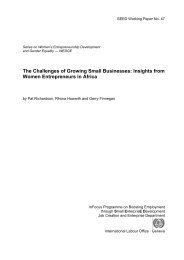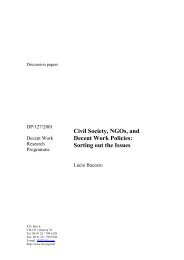manual: women workers' rights and gender equality - International ...
manual: women workers' rights and gender equality - International ...
manual: women workers' rights and gender equality - International ...
You also want an ePaper? Increase the reach of your titles
YUMPU automatically turns print PDFs into web optimized ePapers that Google loves.
Seedling helps soil; <strong>women</strong> help men<br />
Men are front legs; <strong>women</strong> are rear legs<br />
Woman is beautiful because of attitude; man is h<strong>and</strong>some because of knowledge<br />
Situation cards:<br />
A happy couple (picture No. 11)<br />
Exercise<br />
Step 1<br />
• Start this session with showing the picture of a happy family. Ask the participants what is<br />
wrong. Discuss this briefly with the following questions:<br />
- Is the situation on the picture possible?<br />
- Why not?<br />
• Explain that the situation shown on the picture is not possible because men cannot become<br />
pregnant <strong>and</strong> <strong>women</strong> do not grow a beard, i.e. biological differences between men <strong>and</strong> <strong>women</strong><br />
can not change.<br />
Step 2<br />
• Tell the participants that during the following exercise they should act according to their own<br />
feelings <strong>and</strong> opinions. Make sure that they feel free to express their own thinking<br />
• Place at both ends of a room two papers, one with a smiling face <strong>and</strong> the other with an angry<br />
face; in the middle you place a paper with a “neutral” face<br />
• Explain that the smile st<strong>and</strong>s for “totally agree” <strong>and</strong> the angry one for “totally disagree”. The<br />
face in the middle means “neutral”<br />
• The participants should take a place along the line according to their opinion about a certain<br />
statement. Tell them that you will interview a few persons along the line to ask them why they<br />
feel as they do, <strong>and</strong> on what experience or belief their position is based<br />
• Read out loud the first statement <strong>and</strong> ask the participants to st<strong>and</strong> in the spot between the two<br />
faces that represents their beliefs<br />
• Interview one or two persons <strong>and</strong> ask them why they think the way they do, <strong>and</strong> on what<br />
experience or belief their position is based<br />
• Repeat this with the next statement. Again, everyone should move to a spot in between the<br />
two faces that represents his or her belief<br />
• Again interview one or two persons<br />
Step 3<br />
• After 5 statements ask the participants to sit down again <strong>and</strong> ask whether they can think of a<br />
difference between the picture with the happy family <strong>and</strong> the statements.<br />
• Start a discussion using the following questions:<br />
- Do they think cultural <strong>and</strong>/or social values have a large influence on what they think?<br />
- If so, can they give examples?<br />
30

















